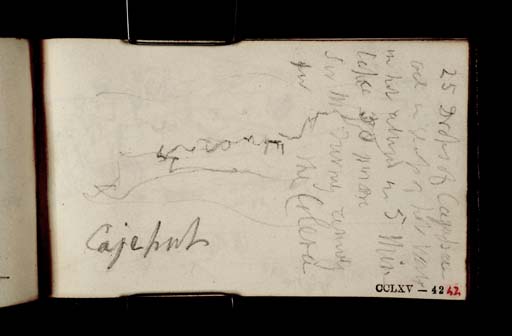J.M.W. Turner
>
1830-35 Annual tourist
>
Scotland 1831
>
Berwick Sketchbook
>
Artwork
Joseph Mallord William Turner Cholera Remedy; and Buildings on Hill 1831
Image 1 of 2
Joseph Mallord William Turner,
Cholera Remedy; and Buildings on Hill
1831
Joseph Mallord William Turner 1775–1851
Folio 42 Recto:
Cholera Remedy; and Buildings on Hill 1831
D25718
Turner Bequest CCLXV 42
Turner Bequest CCLXV 42
Pencil on white wove paper, 59 x 96 mm
Inscribed in pencil by Turner ‘25 Drops of Cajeput | oil in glass of Water | if not relieved in 5 min | take 50 more | Sir M. Tierney remedy for the Colera’ right descending vertically, and ‘Cajeput’ bottom left
Inscribed in red ink by John Ruskin ‘42’ bottom right
Stamped in black ‘CCLXV 42’ bottom right
Inscribed in pencil by Turner ‘25 Drops of Cajeput | oil in glass of Water | if not relieved in 5 min | take 50 more | Sir M. Tierney remedy for the Colera’ right descending vertically, and ‘Cajeput’ bottom left
Inscribed in red ink by John Ruskin ‘42’ bottom right
Stamped in black ‘CCLXV 42’ bottom right
Accepted by the nation as part of the Turner Bequest 1856
References
1909
A.J. Finberg, A Complete Inventory of the Drawings of the Turner Bequest, London 1909, vol.II, p.852, CCLXV 42, as ‘Buildings on hill – “25 Drops of Cajeput oil...”.
1966
Jack Lindsay, J.M.W. Turner: His Life and Work: A Critical Biography, London 1966, p.245 note 11.
1997
James Hamilton, Turner: A Life, London 1997, p.258.
Turner’s inscription provide the directions and dosage of cajeput oil as a remedy for cholera (see inscription line above). Matthew Imms has identified the source of the remedy as Sir Matthew Tierney (1776–1845), the physician-in-ordinary to George IV and William IV,1 whose recipe was printed first in the Morning Herald, 1831 (exact date unknown) and then reprinted in the Mirror, 1831: ‘Cajeput oil, twenty five drops in a wine glass of hot water. If not relieved in five minutes, take fifty more.’2
A cholera epidemic broke out in Britain in the autumn of 1831 and was obviously of great concern to Turner who wrote to Robert Cadell about it on 25 February 1832:
In regard to the Cholera I will thank you to send me the paper which your medical-man printed as to the treatment &c. or if any thing has been discovered during the progress of the disease in Scotland and [in] your opinion is show (contagious or Epidemic) for known cases.
Here the dispute runs high and no treatment made known or Cholera Hospitals Established – some will have it is typhus owing to the state of the Winter which has been very damp and partic[ularly] foggy.3
Here the dispute runs high and no treatment made known or Cholera Hospitals Established – some will have it is typhus owing to the state of the Winter which has been very damp and partic[ularly] foggy.3
Cadell replied to Turner’s letter on 3 March, answering his concerns about the outbreak.4 As Turner was in Scotland when Tierney’s recipe was published, it is possible that it was Cadell who drew his attention to the recipe in the first place.
With the sketchbook inverted is a rough sketch that Finberg described as ‘Buildings on [a] Hill’;5 with its lack of topographical detail no more can be added to his description.
Thomas Ardill
November 2010
Deborah Brunton, ‘Tierney, Sir Matthew John, first baronet (1776–1845)’, Oxford Dictionary of National Biography, Oxford University Press, 2004, accessed 11 November 2010, http://www.oxforddnb.com/view/article/27441.
Turner to Robert Cadell, 25 February 1832, John Gage, Collected Correspondence of J.M.W. Turner with an Early Diary and a Memoir by George Jones, Oxford 1980, pp.147–8 letter 174.
How to cite
Thomas Ardill, ‘Cholera Remedy; and Buildings on Hill 1831 by Joseph Mallord William Turner’, catalogue entry, November 2010, in David Blayney Brown (ed.), J.M.W. Turner: Sketchbooks, Drawings and Watercolours, Tate Research Publication, December 2012, https://www


